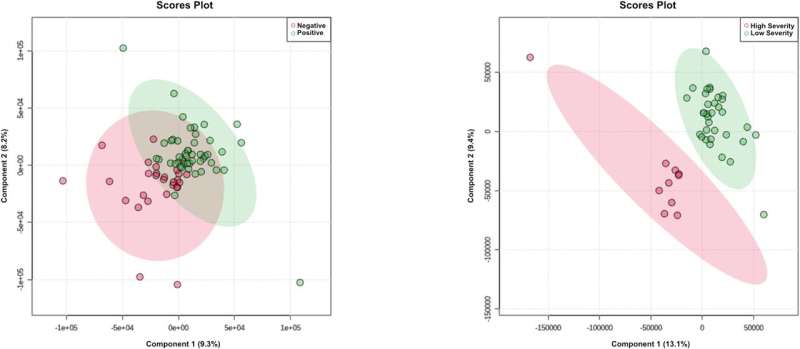Saliva metabolomics analysis for COVID-19 diagnosis and prognosis via LC-MS in positive mode, showing: A PLS-DA plot for 75 participants and 324 features, COVID-19 positive / negative. B PLS-DA plot for 44 participants and 324 features, high severity / low severity. C LOOCV confusion matrix, COVID-19 positive / negative. D LOOCV confusion matrix, high severity / low severity. Credit: PLOS ONE (2022). DOI: 10.1371/journal.pone.0274967
Saliva samples could soon be key to predicting the severity of someone's case of COVID-19, allowing hospitals to triage patients effectively, according to new research from the University of Surrey.
The research team found that amino acids in saliva could help health care professionals separate patients that suffer from a severe form of COVID-19 from those with milder cases. The tests currently used for COVID cannot predict severity.
Professor Melanie Bailey, co-author of the study from the University of Surrey says that "it is unlikely that we will completely eradicate this awful disease from our lives, so it remains crucial that we develop tools and processes to detect COVID-19 better and, hopefully, predict how it will impact different patients differently."
"Our experimental study has found that this non-invasive method of simply collecting someone's saliva can accurately determine whether someone is going to develop a severe case of COVID-19, potentially supporting the prioritization of swift medical interventions in the future."
The study collected saliva samples from 75 individuals in a hospital setting. While all participants were recruited with at least a suspicion of having COVID-19, only 47 of them presented a positive COVID-19 PCR test. Of the positive participants, 10 were classed as showing high severity COVID-19, 34 were classed as presenting with low severity COVID-19, and three lacked sufficient clinical information for severity scoring.
The team found that amino acids changed the most when looking at the difference in saliva samples between patients with low and high severity of COVID-19. This makes the metabolite a promising candidate for a future test that could help identify patients that need the most urgent care.
Cecile Frampas, co-lead of the study from the University of Surrey says that they "were really surprised that saliva could be so informative. A non-invasive way of determining which patients need treatment could be really useful in health care settings in the future."
Investigating non-invasive testing for COVID-19 is a key focus for the team at the University of Surrey. They have previously published work on the possibility of using swab samples to collect sebum—an oily substance produced by the body's sebaceous glands to determine whether someone has COVID-19.
The paper has been published in PLOS ONE.
More information: Cecile F. Frampas et al, Untargeted saliva metabolomics by liquid chromatography—Mass spectrometry reveals markers of COVID-19 severity, PLOS ONE (2022). DOI: 10.1371/journal.pone.0274967
Journal information: PLoS ONE
Provided by University of Surrey























